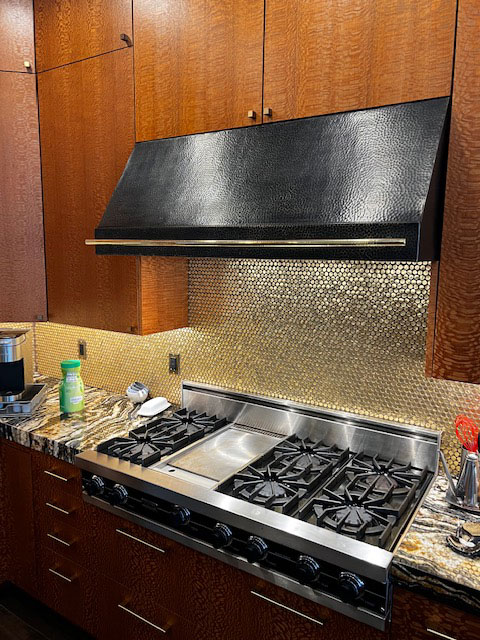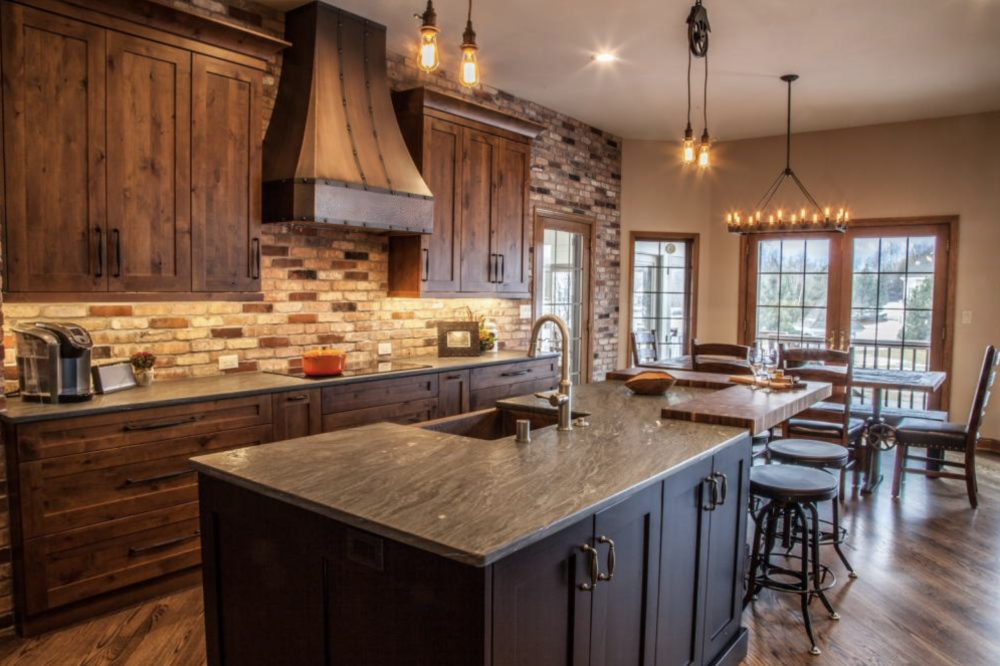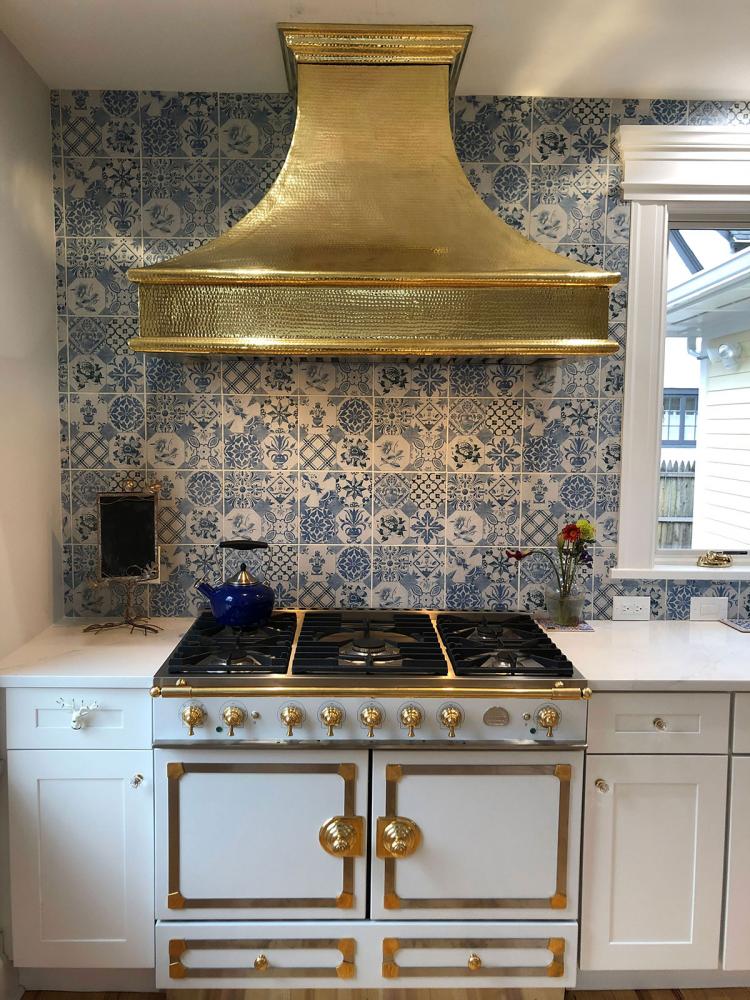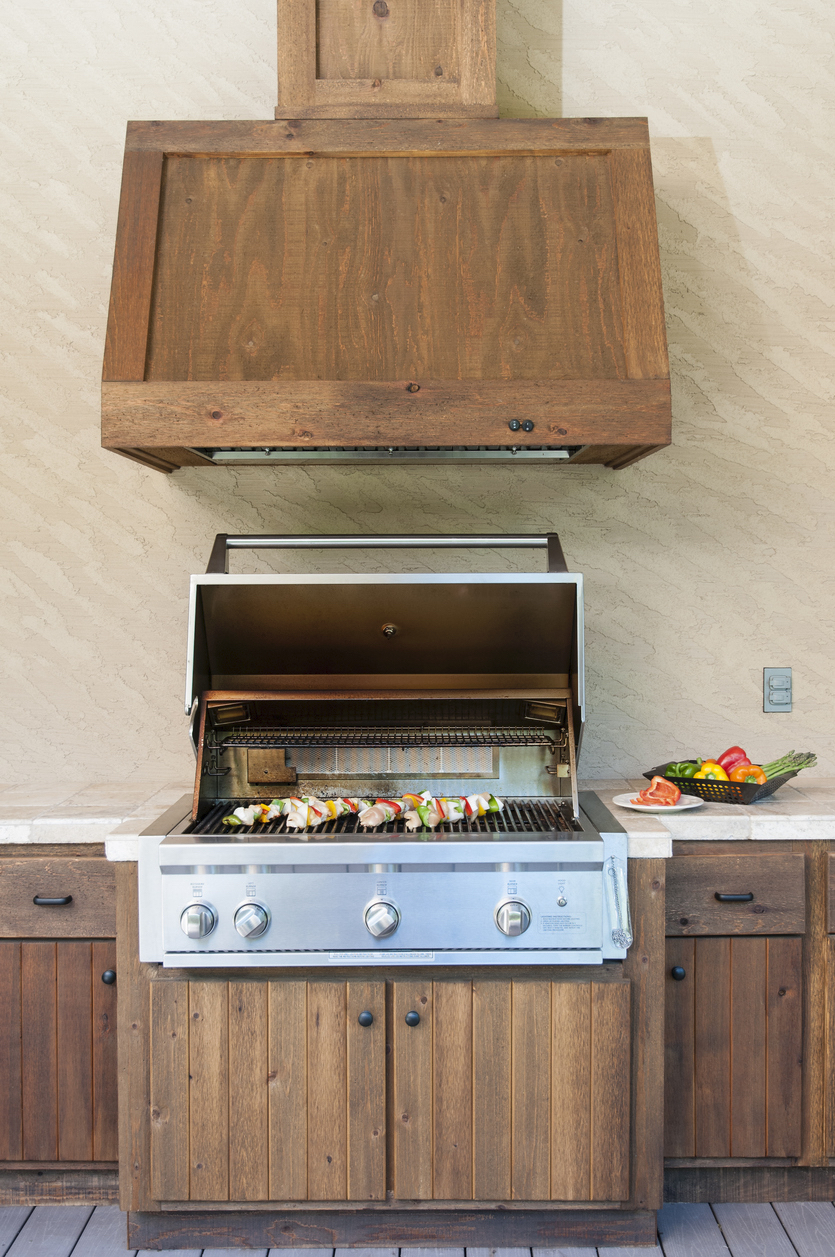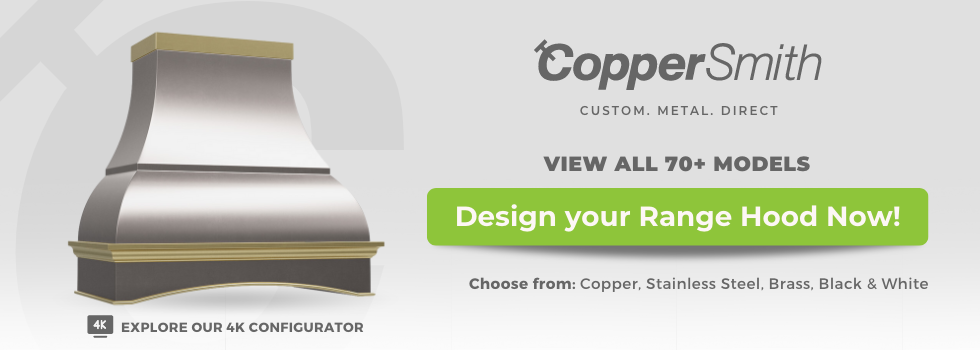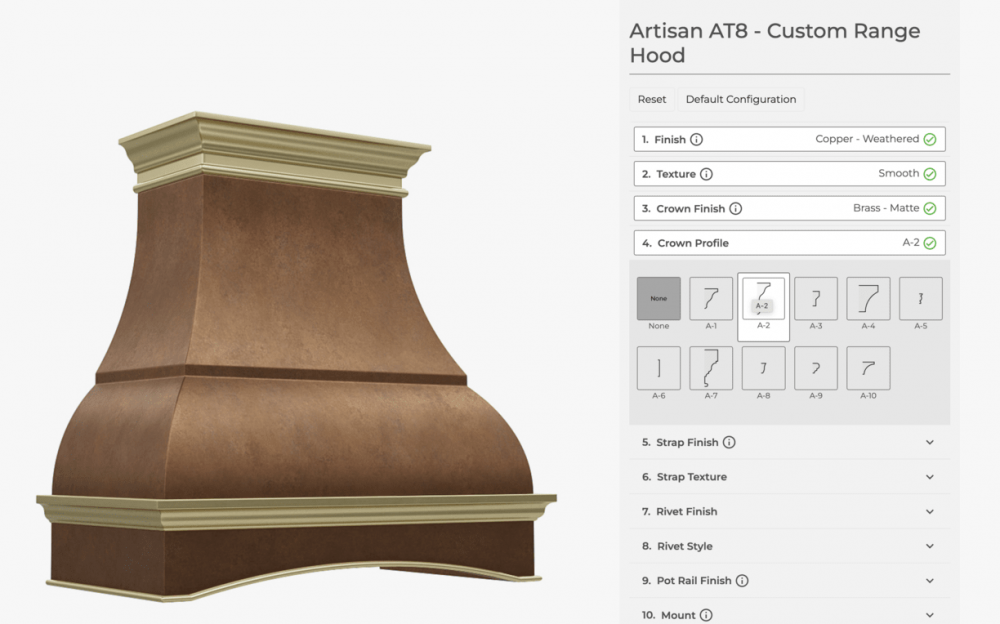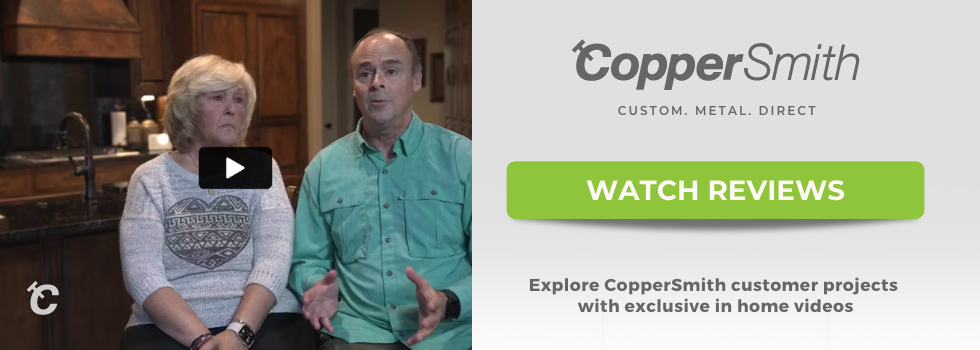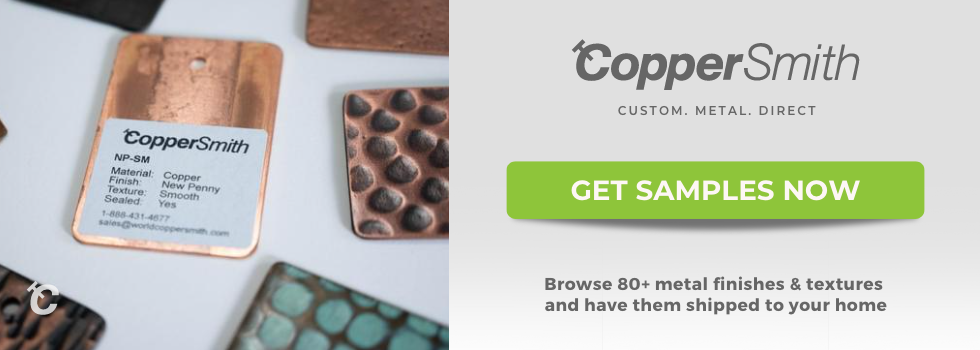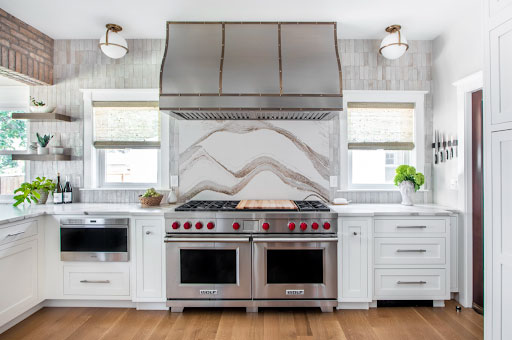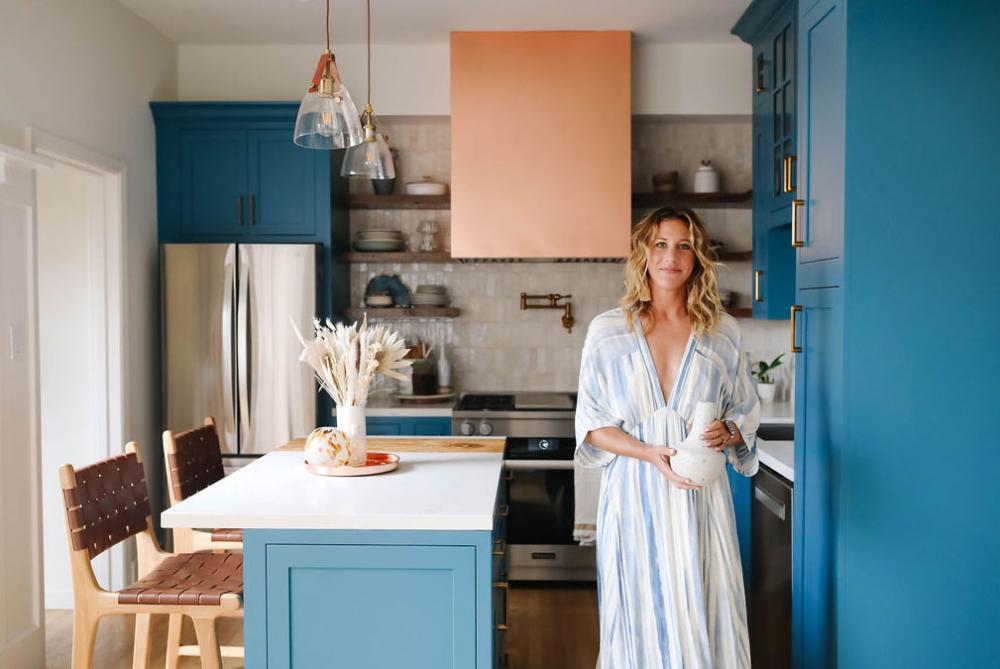
A range hood (also called ventilation hood) provides ventilation for your kitchen. Range hoods are often taken for granted and underappreciated yet provide an essential role in maintaining the health of your home. An adequately ventilated kitchen improves the indoor air quality of your home and refreshes the air you breathe, both of which can be beneficial to the health of your family and the cleanliness of your home. A range hood ventilates the kitchen by removing excess cooking heat, moisture, steam, cooking odors, and airborne particles, such as cooking grease before they can deposit onto your kitchen cabinets, walls, drapery, carpet, or clothing. It can also help remove carbon monoxide from a gas cooktop and chemical vapors associated with household cleaning products.
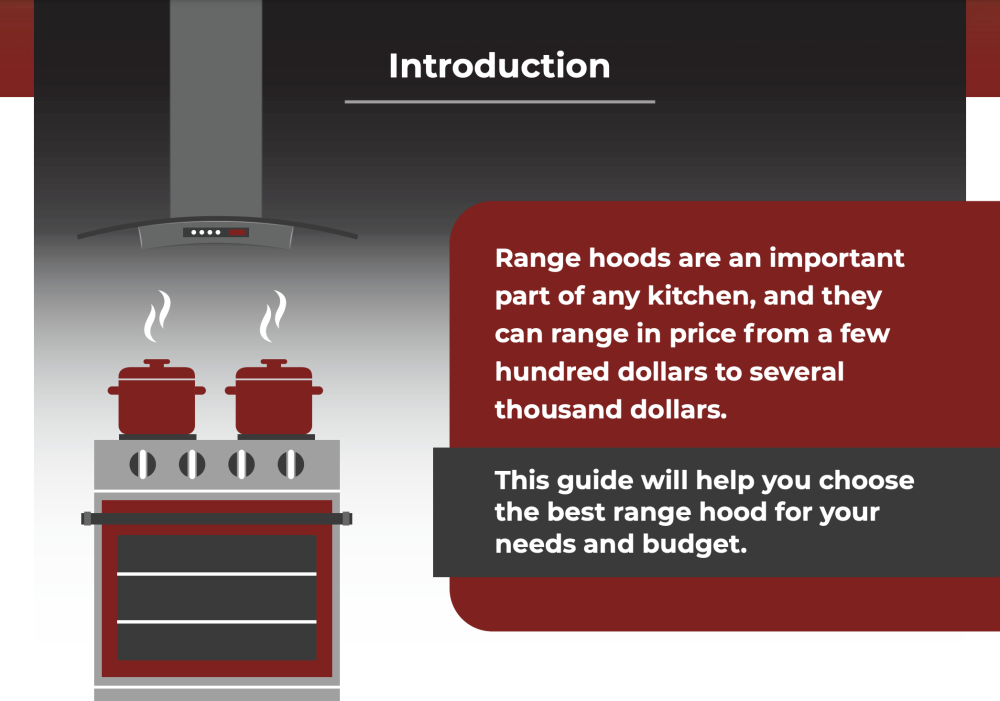
What Are the Key Benefits of RangeHod Ventilation?
- Removes excess cooking heat, moisture, steam, vapors, odors, and airborne particles
- Reduces mold and bacteria build-up on countertops and cooking areas.
- Prevents cabinet damage by reducing grease build-up and condensation of acidic contaminants.
- Decreases mildew, peeling, and discoloration of wall finishes.
- Provides extra lighting over your cooking appliance and prep area, making it easier to see the details when cooking or cleaning.
- Enhances the look of your kitchen and adds to the resale value of your home.
- Gives you the freedom to cook what you want, without concerns about lingering cooking odors.
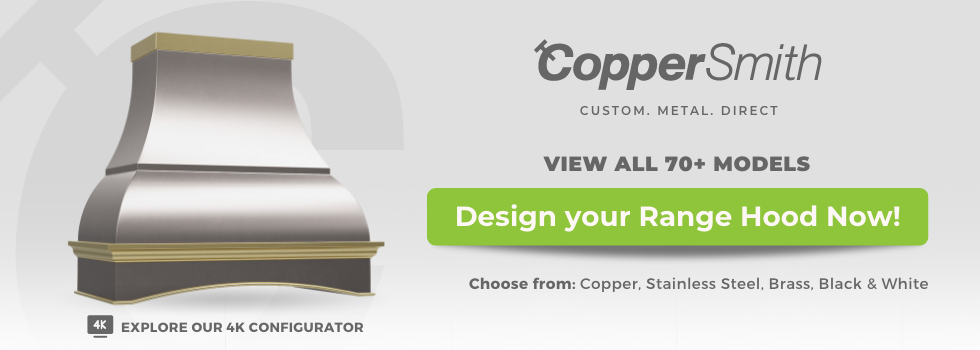 Range Hood Types
Range Hood Types
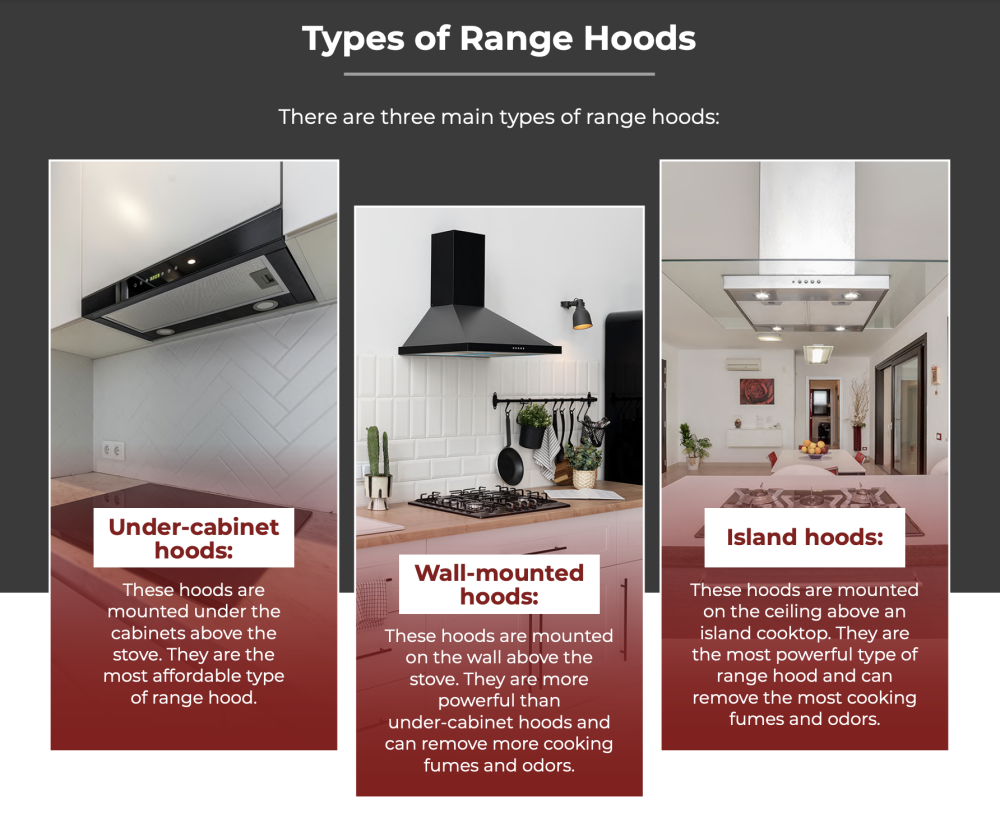
Range hoods come in a wide variety of styles, shapes, materials, colors, and finishes. The right range hood for your kitchen depends on many factors, including kitchen size and layout, cooktop location, kitchen cabinet configuration, budget preferences, and venting options available for your home. When selecting a range hood, the primary consideration is the venting options available for your home, which can significantly widen or limit your choice of range hood. The exhaust generated from a range hood must be vented somewhere—it will either go outside the kitchen or directed and dispersed throughout the kitchen.
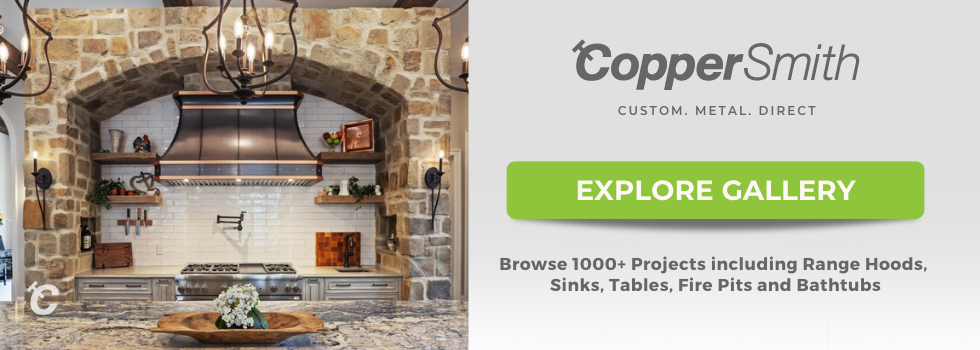 Range Hood Styles
Range Hood Styles
After you have determined what your venting options are for your kitchen, you are ready to choose from the many range hood styles available. As you compare range hood styles, you must consider the layout of your kitchen and cooking appliances, kitchen cabinet configuration, placement of the range hood, design preferences, and budget.
Undercabinet/Undercounter Range Hoods
The undercabinet range hood is the standard and most affordable style of range hoods. They are located directly above the cooktop and mount to the bottom of a wall cabinet, making them ideal for kitchens that lack space. In some space-saving models, a shallow range hood slides out of the upper kitchen cabinet when you need it. If the range hood is on an exterior wall, ductwork can be routed up through the cabinet and then outside, or for some models, directly through the back of the hood.Otherwise, ductwork must be routed through the cabinet to a chase, soffit or ceiling. Ductwork inside an adjoining wall, chase, soffit, or ceiling can exhaust smoke and fumes to the outside. Although ductwork for a vented range hood will likely reduce the amount of usable kitchen cabinet space, the benefits for venting outside far outweigh this loss. Some popular companies in this space are, pacair range hoods and the nutone allure range hood.
Built-In Cabinet Range Hood/Cabinet Insert
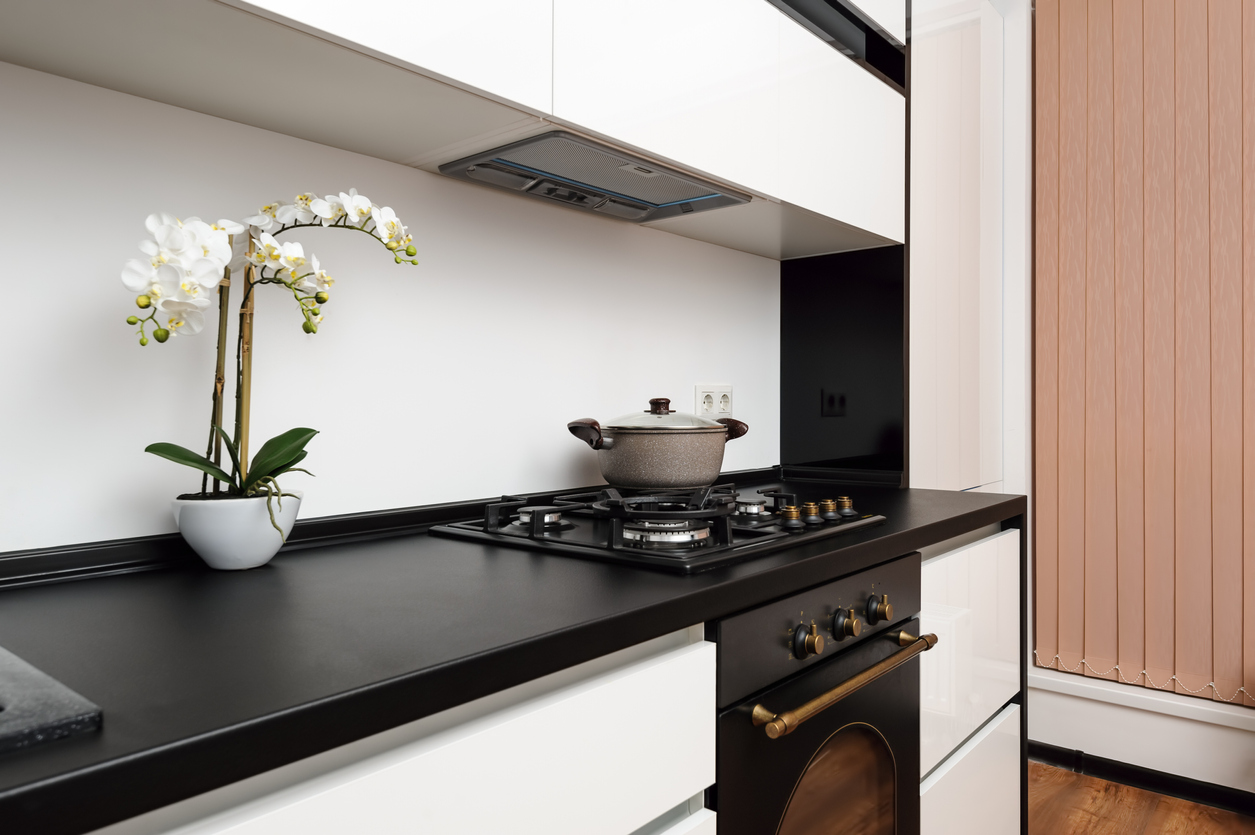
A built-in cabinet range hood is hidden, designed to be built into the kitchen cabinetry above the cooktop for a custom approach to venting and designed to fit flush with the bottom of the cabinet. These range hoods are typically vented outside, but there are also some ductless recirculation models with charcoal or activated carbon filters available.
Wall Mount Hoods
Wall-mount copper range hoods work well in kitchens lacking cabinets over the cooktop or range. These exposed stacks typically take the form chimneys or canopies and are mounted directly above the cooktop or range to catch cooking fumes, smoke, steam, or grease. Although most wall-mounted hoods are vented to the outside, some models can be used for ductless setup. Wall-mounted hoods can have internal or external blowers, ducted straight to the back, straight up, or up and horizontal. These range hoods help highlight the heart of your kitchen by making the stove or cooktop a focal point.
Island/Ceiling Mount Hoods
A range hood for island is designed for use over your island cooktop and are suspended from the ceiling over an island or peninsula. They can also be hung from peninsula wall cabinets. Island range hoods are finished on all sides and tend to be more expensive than other range hood styles. Some include telescoping chimneys to fit ceilings of varying heights. Since islands lack cabinets or walls to help direct cooking fumes up the vent, the canopy of an Island hood must be wider than the cooking surface to funnel the fumes. Island range hoods, like wall-mounted hoods, are striking and become a key focal point in the kitchen. They are growing in popularity with the growth of modular-style kitchens, where the cooking hub is in the center of the room.
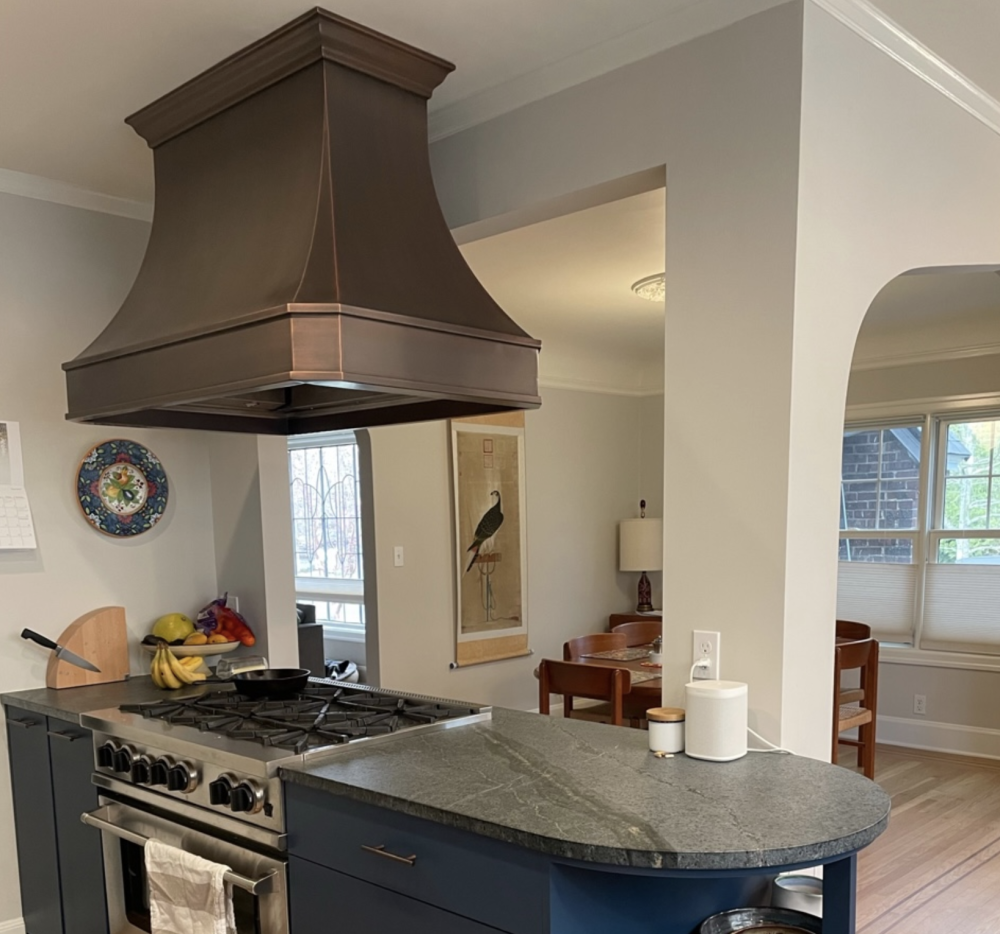
Downdraft Hoods
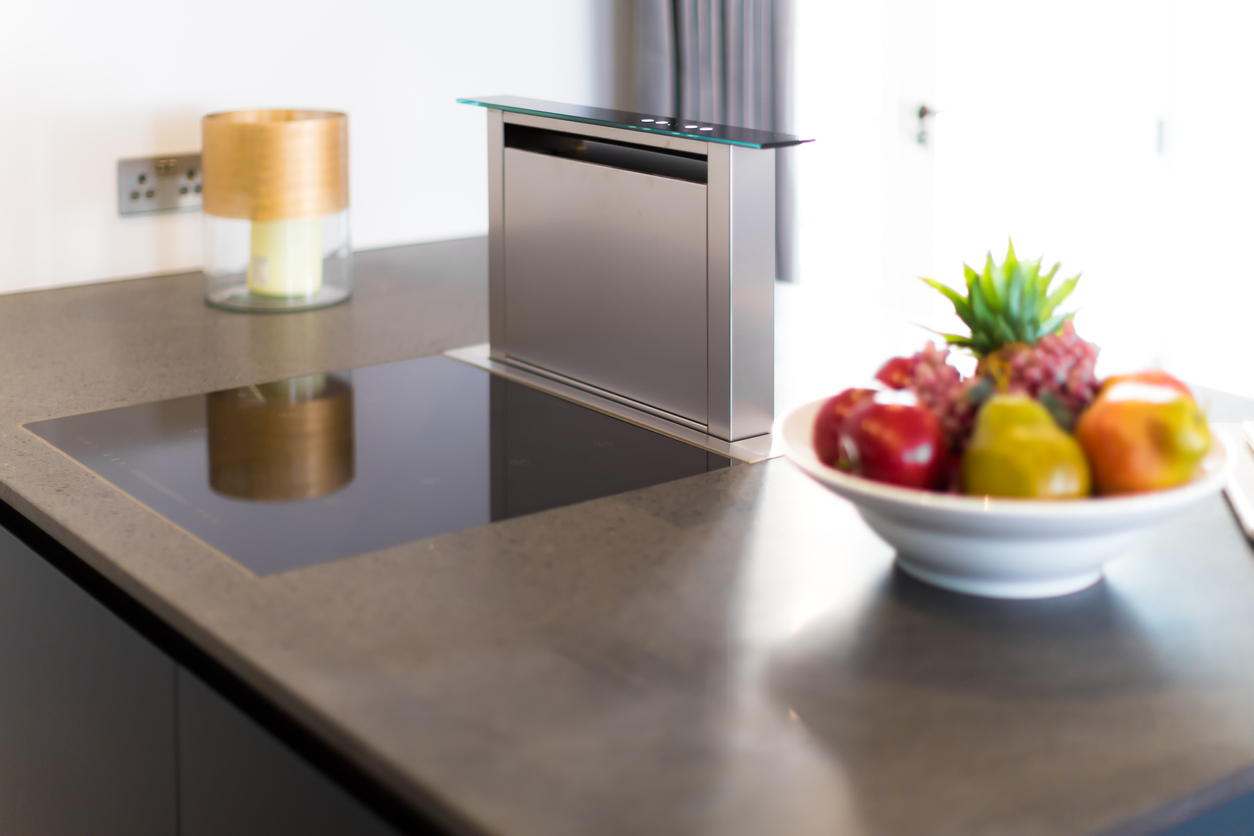
Downdraft range hoods can be used anywhere in the kitchen. Their main application is in a kitchen island, where it might not be possible to route ductwork through the ceiling. They feature a unique space-saving design and are a perfect solution for kitchens with space limitations. They offer an unobstructed view and streamlined look in an open concept kitchen design where cooktops are frequently found in island and peninsula layouts. Available in a flush-mount configuration or in a pop-up design that retracts, removing the range hood from view when it is not in use. These range hoods draw air, smoke, and grease downward through vents, where the exhaust is expelled into ducts beneath the floor or into a basement and outside the home. Downdraft range hoods are considered less effective for ventilation as opposed to other vented range hood styles.
Custom Range Hoods
Customers who want to personalize the look of their range hood or match their range hood to their exact kitchen design specifications can order a custom range hood. Since they are customized, they are more expensive than other range hood styles. Custom range hoods include an external enclosure and an internal ventilation system.
Range Hood Inserts/Power Packs
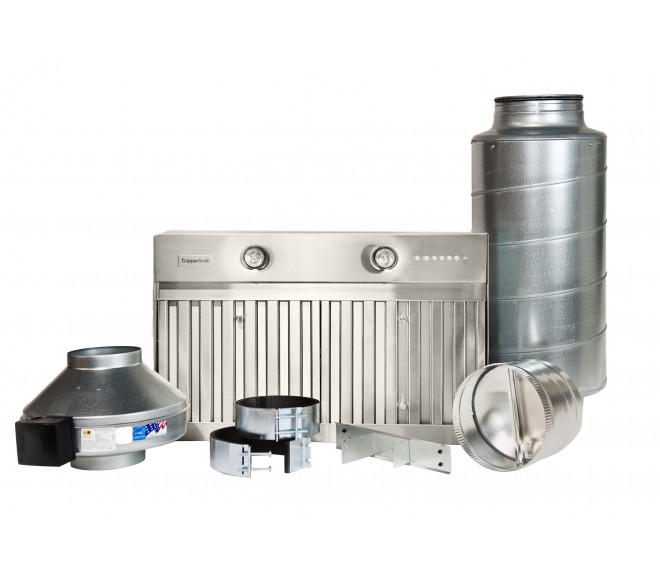
Range hood inserts, also referred to as power packs, are the working ventilation “guts” of the hood that is placed within a custom range hood enclosure. These guts include the blower, filter, lights, and controls. Some of these units can also be customized to include optional features, like heat sensors or halogen lights.
Outdoor Range Hoods/BBQ Hood
Outdoor cooking has now become outdoor living. Many homes today have large, built-in outdoor kitchens replete with ranges, cooktops, grills, kitchen islands, walls, and furnishings. Cooking outdoors can generate intense heat and lots of smoke and grease and necessitate an outdoor range hood to clean the air. Outdoor range hoods are approved and rated for use outdoors. They can be mounted on a wall or hung over a kitchen island. Outdoor range hoods should extend the cooking surface by 3 inches on each side. For example, if you have a 36” grill, you need a 42” hood. The hood should also be deep enough to accommodate the deeper outdoor kitchen countertops, which are typically at least 30 inches deep (at least 6 inches deeper than indoor countertops).
OTR Microwave Hood Combination
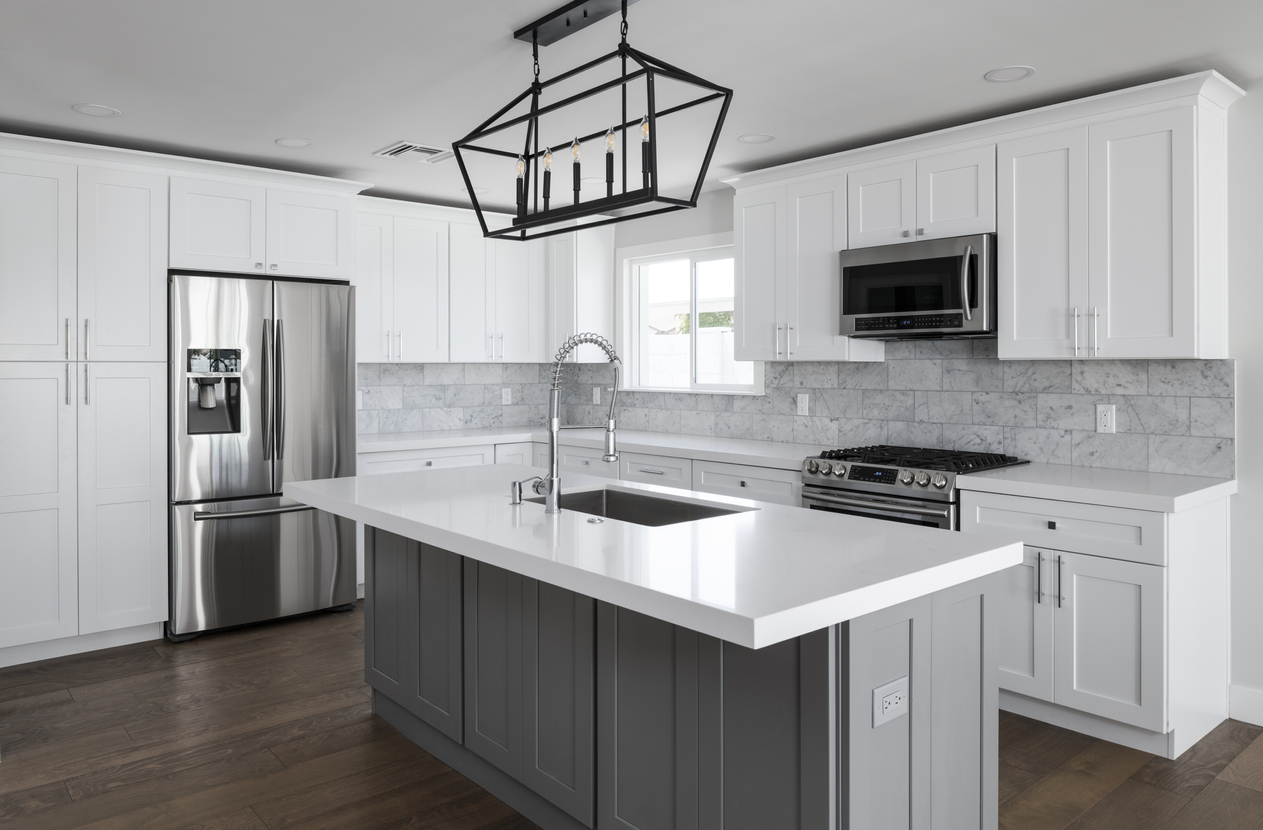
Another appliance that helps ventilate the kitchen is the Over The Range (OTR) Microwave and range hood combination. Depending on the size and layout of the kitchen, the OTR is sometimes used in place of a range hood. It combines the ventilation function of an undercabinet range hood with that of a traditional microwave. Although OTRs provide some ventilation, they lack the strong ventilation ability of a true range hood. You will have improved ventilation by choosing to replace microwave with range hood.
Commercial Range Hoods
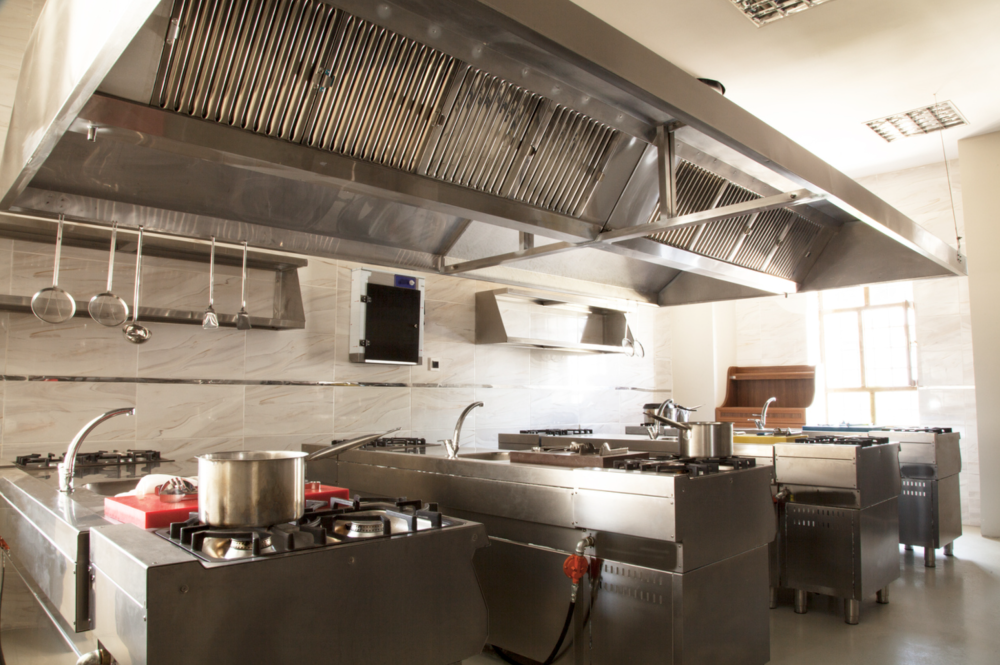
These range hoods can be found in restaurants and commercial food preparation companies around the world. You'll be looking at large sizes, big CFMs, and professional-grade parts. Expect to pay a premium price for the product and installation. Keep in mind - to keep your resturant air quality high - and environment appealing, you'll need an effective and as quite of the system as possible. For commercial, you will typically be best off working with a local HVAC company.
Exterior Vented
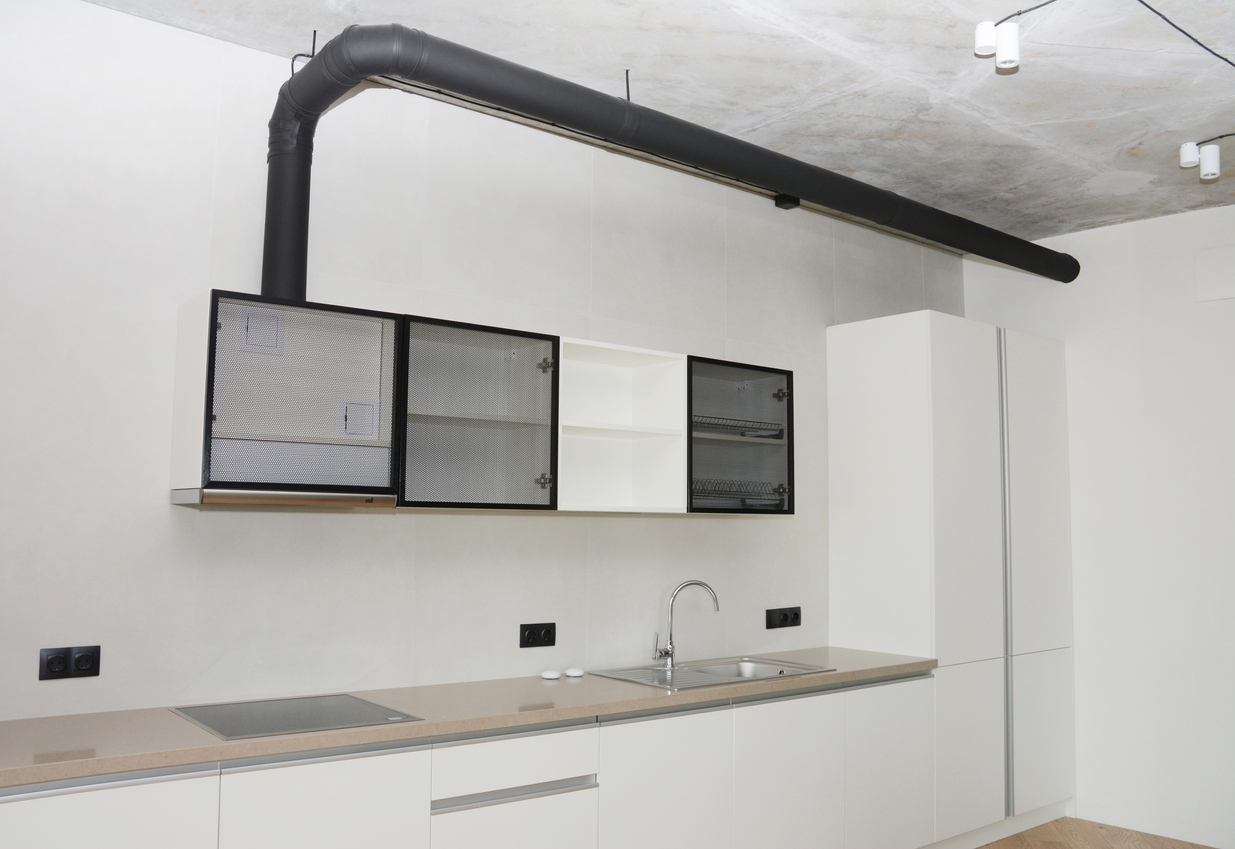
This type of range hood vents to the exterior of the home. It removes smoke, odors, and heat from inside the kitchen and forces it outside. A vented range hood is highly effective at eliminating cooking contaminants from the air. Although vented range hoods are highly effective at removing airborne cooking pollutants, they must be installed in an area with ductwork that goes from the inside of the kitchen to the outside of the home. This can limit the areas in the kitchen where you can position your cooking appliance and range hood. If ductwork is not already installed in your kitchen, the cost of installing a vented range hood can be cost-prohibitive.Installing ductwork is not an easy task for DIY and is best left to the professionals.
Non-Vented, Duct-Free/Ductless, Recirculated
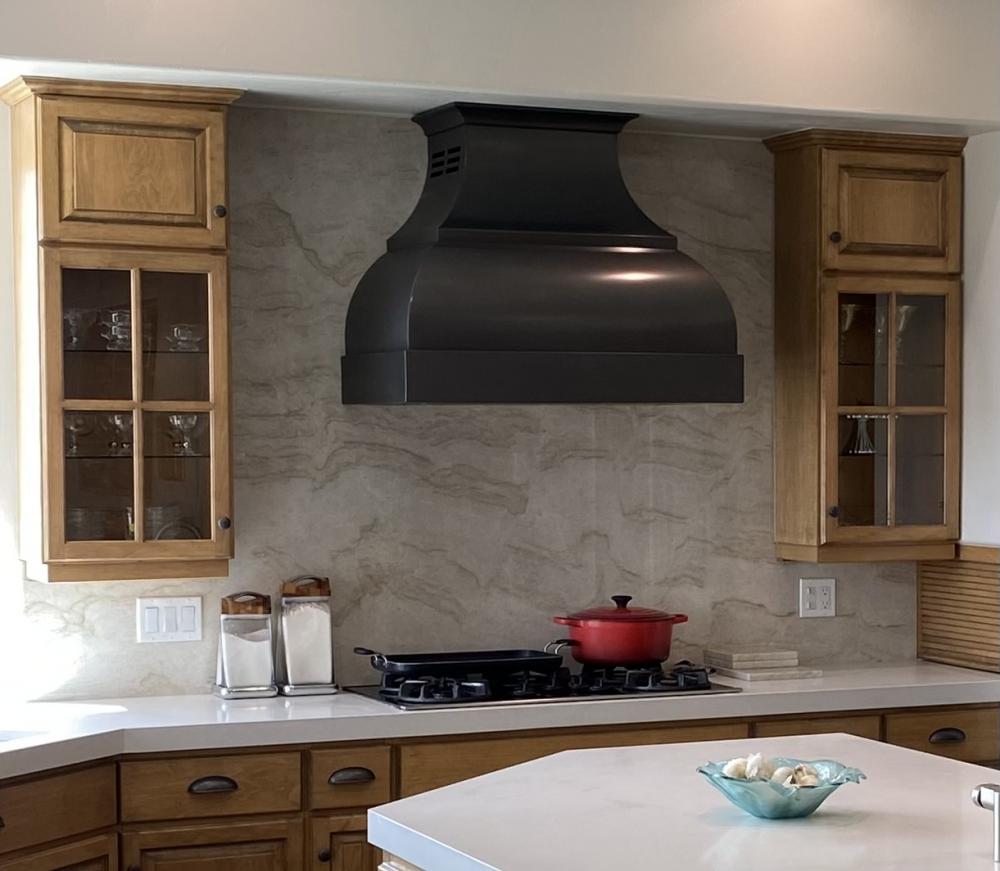
This type of range hood installation is unvented. Instead of venting to the outside, cooking odors and airborne pollutants are directed and dispersed away from the cooktop and into the rest of the kitchen. Some models of ductless range hoods are fitted with replaceable filters made with activated carbon or charcoal, which helps to remove odor and smoke particles from the air before recirculating back throughout the kitchen. Many consider the ductless range hood to be less effective at cleaning the air than a vented range hood. Although less effective, a ductless range hood is not dependent on ductwork and can be placed anywhere in the kitchen. A non-vented unit is also much easier to install for DIY. Ductless range hoods are also more affordable than vented units.
Range Hood Selection Process
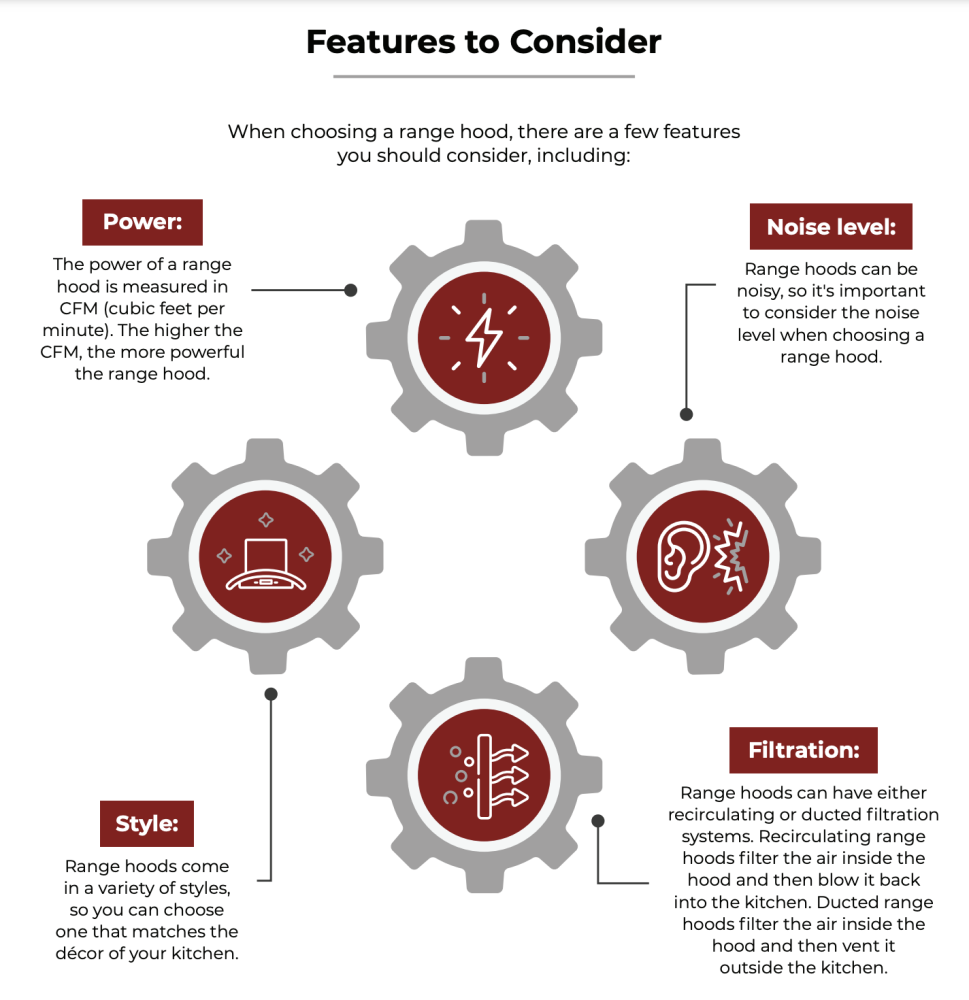
- Measure the width of your cooktop: the range hood must be at least the same width, or preferably several inches wider than your cooking appliance. Range hood widths range in size from 21 to 66 inches.
- Identify the location and layout of your cooking appliance; this will help determine the style of range hood you can choose (wall, island, or undercabinet styles).
- Determine where the exhaust from the hood will go. Do you have ductwork that will allow for a vented hood, or will you need a ductless hood?
- Determine your fuel source for your cooktop—is it gas or electric? Gas cooktops can produce carbon monoxide and require better ventilation than an electric cooktop.
- Consider your cooking habits and the types of foods you prepare. The more you cook, and the more frequently you use a cooktop to prepare your meals, especially for wok cooking or strongly seasoned foods, the better ventilation and a more powerful range hood you will need.
- Determine your budget preferences. Range hood prices vary depending on style, brand, model, and material, and can cost less than $100 to $5000 or more, not including installation.
- Determine your installation preferences—DIY or professional installation. Certain styles, such as Island range hoods, are much more difficult to install and may require the skills of a professional.
Airflow Strength / Range Hood Power
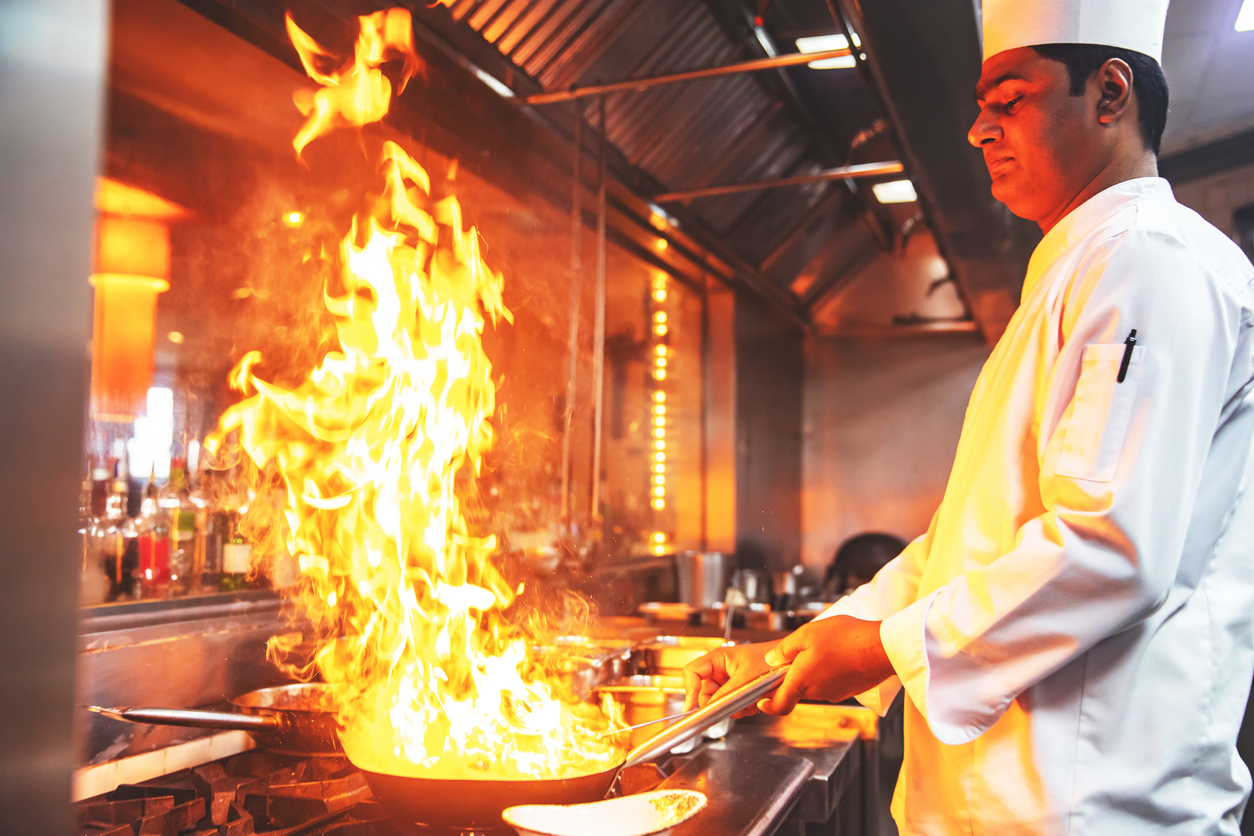
Measured in CFMs or cubic feet per minute (of the volume of air being exhausted through the range hood) CFM ranges from under 100 to 1200 + More airflow means faster ventilation, and in general, the higher the CFM, the better the airflow The larger and more powerful your cooktop burners are, the more CFM is needed. Rule of thumb, for electric cooktop: CFM is estimated by the size of the cooking surface. You need 100 CFM per every linear foot of cooking surface; Island Hoods require 150 CFM per linear foot to compensate for cross-drafts. Rule of thumb, for a gas cooktop: for every 10,000 BTU your stove generates, you’ll need 100 CFM. Using this formula, a gas range with 40,000 BTU will require a range hood with at least 400 CFM. Additionally, for every 3 inches a hood exceeds the suggested height above the cooktop, add 100 CFM.
Fan Loudness/Noise Levels
Noise levels associated with range hoods can vary greatly, depending on brand, model, CRM level, and fan speed. In general, the higher the CRM, the louder the noise. Personal preference determines what level of range hood noise is acceptable. Range hood noise is measured in sones. One sone (28 decibels) is equal to about the sound of a refrigerator hum, while normal conversations are at about 4 sones (48 decibels). Range hoods can generate anywhere from 2 to 8 sones.
Fan Speeds
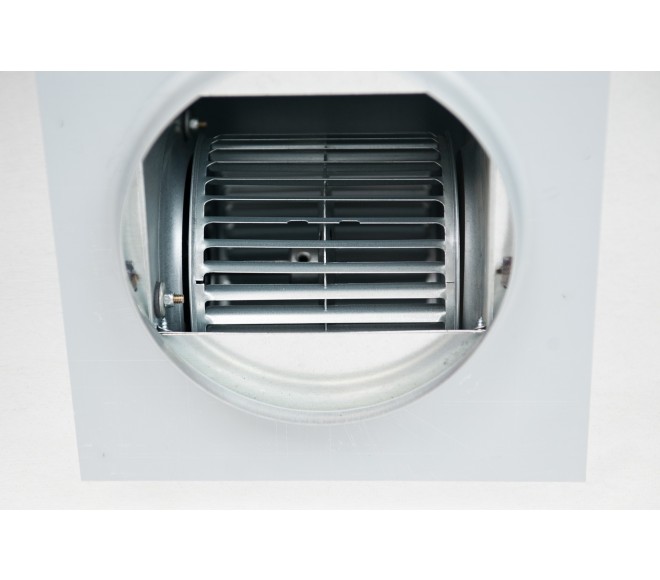
Range hoods can have anywhere from 2 to 6 speeds. Some models offer variable fan speed control. Similar to a dimmer switch, variable speed control allows an infinite adjustment of fan speed based on preference.
Range Hood Filters/Grease Traps
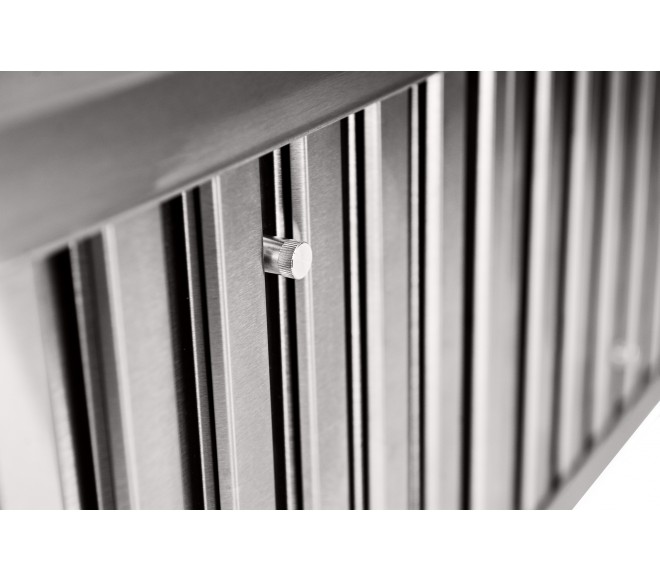
Baffle: More common on high-CFM units, these slat-style metal filters force the smoke to change direction several times, causing grease droplets to separate from the air and drip down into a tray that can be taken out for cleaning. Mesh: The hood's blower pulls smoke and vapors through several layers of aluminum or stainless-steel mesh, catching the grease. These removable filters should be cleaned regularly—most can be popped into the dishwasher—to prevent clogs that can slow airflow. Filter-less/centrifugal trap: Centrifugal force within the blower liquefies grease, which is collected in a tray or a cup that's removable for cleaning. With no filters to slow the airflow, these hoods require fewer CFM than those with baffles or mesh to do the same job, often with less noise. Activated Carbon or Charcoal Filters: these are disposable filters for ductless range hoods that must be replaced every few months to maintain their effectiveness at filtering the air of pollutants before recirculating back into the kitchen.
Lighting
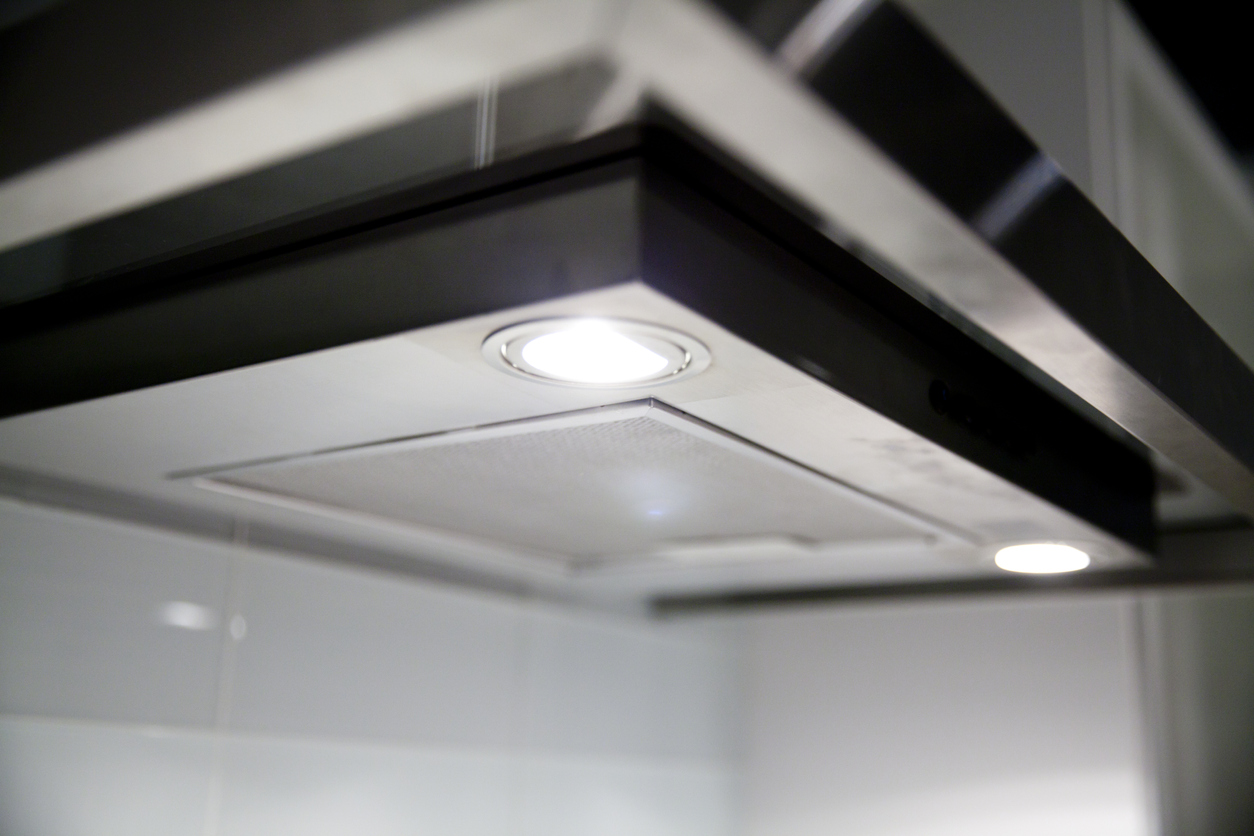
Range hoods provide additional lighting directly over the cooking surface to help illuminate the prep and cooking area. Different range hood models offer different lighting options, anywhere from 1 to 4+ lights.Lighting can be LED, Halogen, or Fluorescent. Some range hoods include low light settings, useful for night lighting. Others offer colored, ambient lighting, which can alter and enhance the look and mood of the kitchen.
Blowers
Internal/Local: Refers to a blower that is built-in to the range hood body; this is usually the loudest type of blower. In-Line: This blower type is installed in the ventilation ducts between your hood and the outside vent. Typically, it’s installed in the attic or basement, making it easier to service. An in-line blower is quieter to operate than an internal blower since the fan is located farther away from the kitchen. This type of blower is beneficial with homes with long duct runs or several turns in the duct. External: Refers to a blower that rests on the outside of the home, either mounted on the roof or on an outside wall. Since external blowers are located some distance from the kitchen, they are typically the quietest option. This type of blower requires a more complex installation process.
Other Options
Thermostat Control/Heat Sensor: By sensing temperature changes, some units will turn on the fan automatically or adjust to the appropriate speed if the temperature below the hood gets too high. Exhaust Timer: The fan can be preset to shut off at a specified time interval. Auto On/Off: Ability to preset fan on/off times. Food-Warming Capability. Auto Extend and Retract or Auto up and down: Some range hood units are retractable when not in use, and offer a remote-controlled or push button auto-extend and retract feature
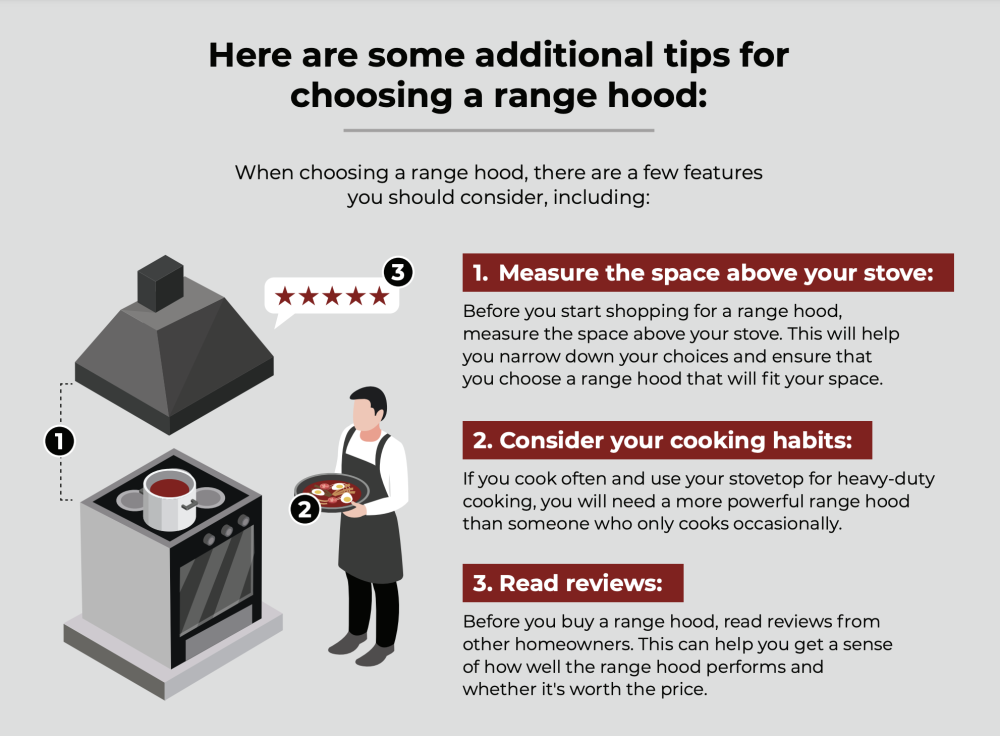
Design Elements
Range hoods come in a variety of design styles to choose from, from traditional to modern. One of the most popular range hood styles is the “pro”style. These larger hoods have a commercial or professional chef vibe. Pro-style hoods are usually crafted from stainless steel and equipped with greater CFM power. Specifically designed to operate over higher BTU pro-style cooktops and grills. They are available in wall-mount, Island mount, or undercabinet mount.
Color, Finish and Materials
Range hoods come in a variety of finishes and colors. Popular metal finishes include brushed, polished, antique, and hammered metal. Trending colors include classic white and black as well as dramatic colors like red, blue, yellow, or turquoise. Special finishing touches, including metal rivets and straps, are also trending. Range hoods are made from a variety of materials, including stainless steel, copper, bronze, nickel silver, zinc, tempered glass, wood, aluminum, brass, heat-resistant plastics, and more.
How much does a range hood cost?

The price of a range hood varies greatly, depending on many factors, including exhaust type, mount style, brand, CFMs, options, and so on. The most affordable range hood type and style is the standard ductless undercabinet mount, with pricing starting at $100.00 or less. Wall-mounted and Island range hoods are more costly, with prices from $150.00 to $5000.00 or more. Copper range hoods are the most expensive, with prices between $500 to $30,000. Professional range hood installation can cost an additional $300 to $1000, with undercabinet or wall mounted ductless hoods the least expensive to install.
What is a Chimney Extension?
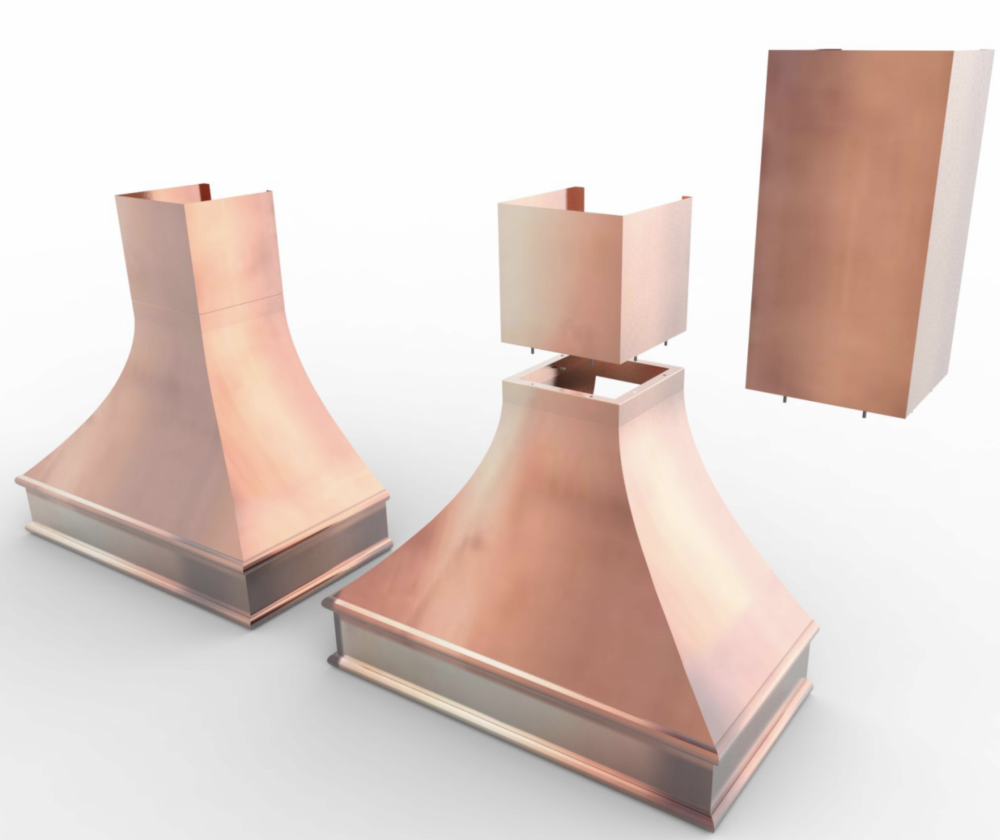
- Depending on the layout of your kitchen, a chimney extension may be required for your kitchen ceiling's height.
- Extension needs will vary by ceiling height and hood type.
- If you have a particularly short or high ceiling, these extensions allow for a customized fit.
- Extensions can hide the ductwork that carries the air to the outside of your kitchen.
- The new homes of today are built to high standards of air “tightness” and often lack enough ventilation or exhaust ports.
- In certain municipalities, range hoods over 400 CFM may require “make-up air”.
- A make-up air unit enables fresh air to enter the home from outside when in use.
- A damper is required as an add-on to the range hood and helps replace the air when the hood is in use.
How to Use a Range Hood
A range hood must be in use to be effective at cleaning the air and ventilating your kitchen and should be used every time the cooktop is used. Yet, it’s interesting to note that according to a recent study, few people use their range hood on a regular basis. There are three main reasons why many don’t use their range hood. 1. Some people don’t understand the benefits of using the range hood 2. Some complain about the loud noise it generates when in use and 3. Others simply never think about using their range hood. A best practice in range hood use is to turn on the range hood 10-15 minutes prior to cooking; this will help establish proper airflow and improve the effectiveness of the hood to clean the air while cooking. Continue running the hood for an additional 10-15 minutes after cooking is completed to help remove any lingering odor, smoke, or grease from the kitchen. To quietly remove any lingering cooking odors, use a low fan speed. Higher fan speeds will help remove odors, heat, and steam when cooking on several burners at once.
How to Clean a Range Hood
Regular cleaning and maintenance of your range hood will ensure optimal performance. Apply a nonabrasive cleaner with a damp sponge and rub the area in the same direction as the stainless-steel grain. Use a stainless-steel cleaner and follow the manufacturer’s instructions. For enamel or powder coated color finish range hood Apply a nonabrasive cleaner with a damp sponge and rub gently until clean. Use a grease cleaner and follow the manufacturer’s instructions. Range hood grease filters can become blocked with grease if they’re not cleaned, limiting the hood's ability to clean the air. Your cooking habits will determine how often you need to clean the filters; more frequent cooking means more frequent cleaning. Experts recommend cleaning the filters after every 30 hours of use (about every month or two) to keep a hood running smoothly.Most vent hood filters can be placed in a dishwasher and cleaned on a low heat or short cycle settings. Some filters may become discolored when using dishwasher detergent with phosphates. Vent hood filters can also be washed by hand, using warm water, liquid dishwashing detergent, and baking soda. Soak the filter for 1 to 2 hours and then rinse. Allow the filter to dry completely before reinstalling.
Essential factors to consider when buying a range hood
There are multiple advantages to buying a range hood for your kitchen but some products may be better suited to your needs than others. If you’re looking to buy a new range hood, here are some essential factors to consider before making a decision:
Size
The size of your range will dictate the size of the range hood you need. We recommend buying a range hood that is at least the same width as the stove, but it’s often beneficial to order a wider range hood to boost exhaust capture. Measure the dimensions of your range before you buy a range hood. If you are remodeling your kitchen, and you plan to install a new cooker, wait until you have chosen a range to order your range hood. It’s important to ensure that the hood is wide enough. If you’re still exploring range options, you may change your mind even if you think you’ve found the stove you want. This could impact your requirements. Always double-check the dimensions of the range before buying a hood.
Location
The location of your stove may affect the type of range hood you need. If your range is set against a wall, for example, you’ll need a different type of range hood to an island stove. Consider the location of the range and the layout of your kitchen when choosing a range hood. You want to ensure that the range hood can be installed seamlessly above the stove or under the counter depending on your kitchen layout and design preferences.
Function
Some people use their kitchens several times a day and they love to cook and entertain at every available opportunity while others only eat at home a few times per week. It’s helpful to think about the function of your kitchen when buying a range hood. If you cook a lot, you’ll need a more powerful range hood. It’s best to look for range hoods that offer optimum ventilation for commercial kitchens, for example.
The way you use your kitchen will affect the choices you make when it comes to the CFM of the range hood. Choosing the right CFM will ensure that your range hood is powerful enough to remove odors, capture fumes and enhance air quality. The more you cook and the more powerful your oven, the higher the required CFM. It’s also advantageous to opt for a higher CFM if you enjoy cooking meals using ingredients that have a strong aroma, such as fish dishes, spicy food, garlic and onions, or you fry food regularly.
Indoor or outdoor
Range hoods are designed for indoor and outdoor kitchens. Although the design and function may be similar, the materials often differ due to the additional challenges and hazards posed by the weather. If you’re looking for a range hood for an outdoor kitchen, you’ll need to make sure that your hood is suited to the conditions. Stainless steel range hoods are a good option for outdoor cooking as they are heat and weather-resistant. If you choose the wrong materials, your range hood may be more susceptible to damage and wear and tear and it won’t last as long.
Style preferences
Kitchen range hoods come in a vast array of styles and designs. One of the most exciting parts of shopping for a new range hood is browsing different options and seeing what kinds of styles are available. At CopperSmith, we have an extensive selection of traditional, contemporary and custom designs to suit every home or commercial kitchen. We have a stunning collection of range hoods to choose from and we provide a custom quote service for bespoke projects. You can select a design you like and customize the size, finish and features to suit your needs. You can also request a custom quote or use our innovative 360 3D configurator to get inspiration for your kitchen. Every customer is different. Some people may be looking to be bold and turn heads with a magnificent traditional copper range hood, for example, while others may prefer a sleek, contemporary stainless steel hood.
Cost
The cost of a range hood varies depending on the style, size, type, materials and power. Before you buy a range hood, it’s important to set a budget and compare prices. Try to prioritize value for money over cost. It makes financial sense to spend more money on a hard-wearing, durable kitchen range hood that will last for several years rather than buying a cheaper range hood that will only work for a few years. Once you have established a suitable budget, you can filter search results and focus on products that match your criteria. If you have a maximum price in mind, the CopperSmith team will be happy to make personalized recommendations based on your requirements and your design preferences. We can help you to modify the customization options to bring products in on budget.
Ceiling height
Most range hoods are designed for kitchens with standard ceiling height. If you have a home that boasts high ceilings, you may need to factor in the cost of adding a chimney extension.
Materials
Exploring different materials is beneficial for both aesthetic and functional reasons. The material you choose will influence the look of the range hood and the overall design of the kitchen, but it’s also important to think about performance. Some materials are better suited to heavy-duty usage in commercial kitchens or withstanding the elements in outdoor kitchens, for example. If you need advice about which materials would be best for your project or remodel, our experienced advisers can help.
Expert tips to find the right range hood
There is an incredible selection of range hoods available. If you’re unsure where to start, or you’re struggling to narrow down your options, here are some expert tips to help you find the perfect product for your kitchen:
Think about how much you want to spend
The cost of buying a range hood can vary hugely. Before you start looking, it’s beneficial to think about how much you want to spend. Are you looking for an affordable, understated range hood for a family kitchen? Do you want to splash out on a stunning custom-designed range hood that will create a spectacular new focal point in your home? Are you on the hunt for the most powerful and effective range hood for a commercial kitchen? Whatever your needs, setting a budget in advance can help you streamline your search and pinpoint suitable products. If you fall head over heels for a design, which is out of your price range, it may be possible to adjust the specifications to lower the price. Examples include changing the materials or finish or downsizing. Contact us for advice if you’re looking for suggestions within a specific price range.
Choose reputable companies
When you buy a kitchen range hood, it’s understandable to want to enjoy peace of mind. You want to ensure that the hood will work properly and that you’ll get the product you ordered on time and at the price you agreed. Always choose reputable companies when ordering a range hood. Research providers, check that websites are secure and read verified reviews and customer testimonials. View examples of previous work, browse product galleries and check information about guarantees and warranties. Ask for a full, written quote before you make a payment and make sure you are 100% happy with the design and customization options if you are modifying a range hood to suit your needs. At CopperSmith, we require client approval for the finished design before the order moves to the fabrication stage.
Celebrate your style
Choosing a new range hood is an integral part of creating a new kitchen or adding interest to an existing design. When browsing images and looking at different styles, celebrate your taste. You can choose to embrace current trends, mix and match styles or go for something unique to set your kitchen apart. At CopperSmith, we have designs to suit every home. Our custom-made products are guaranteed to make a statement.
Check the details before you order
As a customer, you want to ensure that your new kitchen range hood is perfect. From the location and ventilation power to the size and finish, it’s critical to check the details before you place your order. Measure the dimensions at least twice to make sure you order the right size and explore different finishes. Seek expert advice if you have questions about the best type of range hood or the CFM.
History
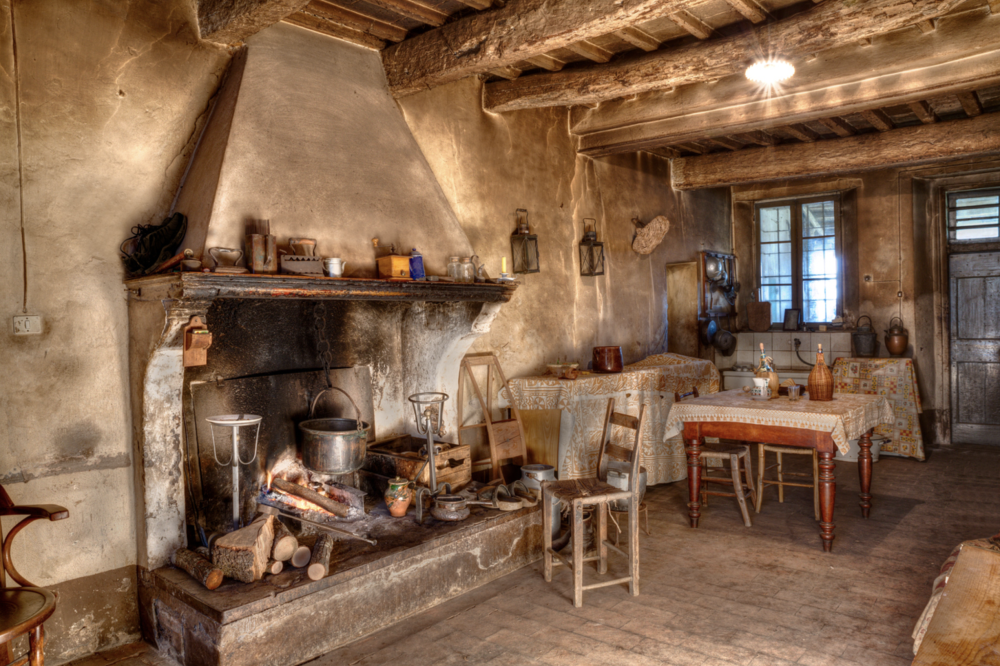
Since the early development of humanity, people have been cooking food with fire. From open flame fire pits to the development of brick and stone ovens, people have turned to natural and later, mechanical means to ventilate the smoke and fumes from cooking. By 1880, technological innovation in the stove led to the development of a fuel-driven heater fan. Outdoor air was drawn into the bottom of the oven and released as heated fresh air into the stovetop. Gas fumes were taken out of the chimney, which created a vacuum that drew out the room air. The warmth of the stove ran thus both supply and exhaust air.
Early Inventors
Since the early 1900s, many inventors have helped develop the modern range hood into what it is today In 1926, Theodore R.N. Gerdes applied for a patent for “ventilating hood for ranges” which used a fan to capture escaping fumes. Two years later in 1928, Lloyd W. Ray developed a ventilation system that separated grease from vapors, pulled heat from under the stove, and helped clean the air. In 1932, Henry Broan developed and manufactured a kitchen fan called the Motordor Fan that provided quiet and efficient kitchen ventilation. Then in 1933, Dallas based Vent-A-Hood Company became the first manufacturer of residential range hoods in the USA. The 1950s and ‘60s saw further development of range hood technology. James A Nelson and Frederick J. Port devised a way to cool the sides and top portions of a range, and William A. Pledger filed several range hood-related patents, including a detachable and replaceable filter “to collect the grease from fumes and smoke drawn off from said ranges.” In 1967, Donald E. King filed a patent for his kitchen exhaust hood with a “drip-proof louver for receiving hot grease-laden air, water spray to cool the hot air and condense the grease and a blower for discharging air drawn into the hood and centrifugally separating water droplets therefrom.” Innovations in range hood technology, materials, and design continue today. For example, in 2017, Robert Siegel (associated with ProLine brand of range hoods) with the help of other inventors, developed new features in range hood automation, including a patented range hood that monitors and responds to changes in air quality during use and includes an alarm with motion detector that adjusts the alarm volume as needed.
Today’s Leading Brands
Over 100 companies that manufacture and distribute range hoods across the globe today. One of the largest manufacturers is Broan-Nutone LLC (that include Broan, Nutone, and Best range hood brands), whose parent company Nortek owns 40% of the market share in range hoods. Range hoods are sold under dozens of brand names. A few prominent brands include Broan, Elica, Faber, CopperSmith, Samsung, Whirlpool, Wolf, Viking, and Zephyr. High-end range hood brands are mainly from Germany, Italy, and the USA, and include Gaggenau, Miele, Bertazzoni, Elica, Faber, Futuro Futuro, ProLine, and Zephyr.
Innovations in Range Hood Technology
Many of the innovations in range hood technology today relate to the advancement of electronic functions and the integration of smart home technology/ IoT. Some range hood brands offer models with electronic controls and WiFi or Bluetooth capability (e.g., Bosch and Samsung). Air quality sensors and alarms are also becoming more popular (e.g., ProLine)LED lights and dimmable and colored lights (e.g., Zephyr), Noise reduction technologies (e.g., Vent-A-Hood)
3 Well-known Range Hood Brands

DCBL Suppression: According to Zephry, the DCBL Suppression system is the industry’s first range hood motor powered by brushless, direct current energy (DC) versus traditional AC energy. This translates to increased power and efficiency while lowering noise and energy consumption. Zephyr claims that this technology is 77% more energy efficient with up to 77% less noise.

The creators of the Magic Lung Whisper Quiet Technology: At high fan speeds, fans with high CFM remain quiet (e.g., CFM 1200 measures 6.6 sones). ARS Patented Duct-Free System: improvements for recirculating range hoods.

This boutique brand is well known among designers, for it's Industry changing customizable options, offering hoods in nearly every type of metal, finish, texture and combination available on the market. Development of innovative software that connects artisans to consumers through a direct to consumer business model. This brand is best known for its copper range hoods and black range hoods.
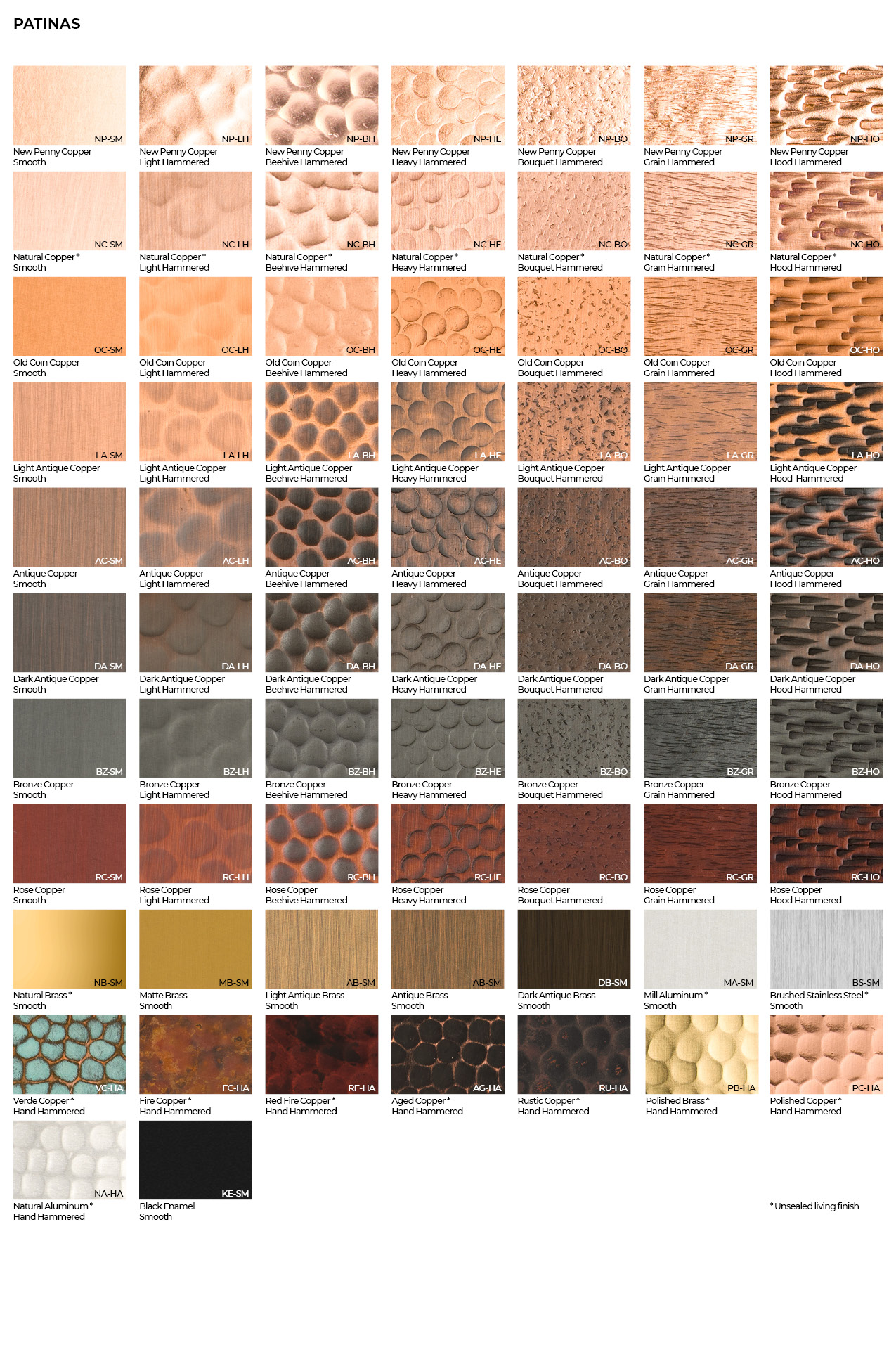
Innovations in Design
Range hood design has come along way in the last ten years. Many of the high-end brands are known and admired for their innovation in design. Here are a few noteworthy design innovations. Miele: Angled wall-mount hood is a flat range hood that integrates task lighting and ventilation, perfect for small kitchens. Faber: Crystal Nest Plus design is a range hood that expands and retracts at the touch of a button. Faber: Talika, completely flat, wall-mounted range hood or Futuro Futuro flat Island model Jenn-Air: Parametric wall-mounted range hood, pulls in smoke through vents around its edges instead of the center, like a traditional hood. Futuro Futuro: Folio black wall range hood CopperSmith: Over 84 finished & texture combinations. Fastest growing range hood company 2010 - 2020. Barriviera Cucina: combo clock and range hood Best by Broan: combo light pendant and range hood Bastille Metal Works: 100% customizable slip-case range hood designs Futuro Futuro: Murano LED Island hoods in a variety of fun designs Elica: the Elica Star: range hood ventilation and lighting, the filters are inside the sphere. Elica: NicolaTesla Switch, the latest design in downdraft range hood and induction cooktop combo Baraldi: offers several hoods (Pratika, shown) that feature DeoTech air deodorizing system, with three fragrances – Deep Clean, Light Breeze, and Home Aroma, that adds fragrance to the kitchen. Silverline: Quadra range hood installs flat into your ceiling for virtually seamless integration. Airone: The Aida can be hidden within the kitchen cabinets. Other companies: hauslane range hood, shiplap range hood, viking range hood, tech range hood.
How to Install A Range Hood
Swapping out an existing range hood with a similar model can be done quite easily DIY. Replacing a range hood unit that will need new ductwork and vents or a new location in your kitchen is a much more difficult process best left to a professional.
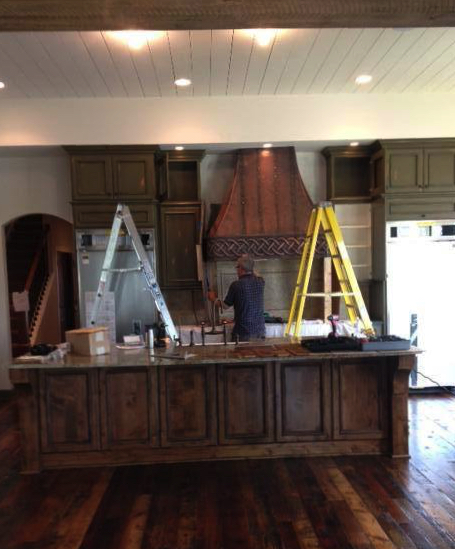
Tips and Advice
Before doing anything, shut the power off at the breaker box. Follow the installation instructions according to the range hood manual. For optimal performance, install a hood between 20 and 24 inches away from an electric cooktop and 24 to 30 inches from a gas cooktop. The higher your range hood is from the cooktop, the less effective it will be, so it is important to compensate for extra height by increasing the CFM and/or coverage (width and depth).
How to Replace Your Old Range Hood
You’ll need your new range and a few tools: a drill, Phillips and flat head screwdrivers, and an a/c detector. Double-check that the power is off, checking with the a/c voltage detector that the wires are not live. Unplug the old hood and disconnect the electrical range wires from the home wiring. Have someone help you lift aside the old hood and remove the support screws that hold the unit to the wall or cabinet. Looking at your new range hood, identify the correct opening for your vent, e.g. rear duct opening, matching up your new vent hood with the same vent opening location for the wires and exhaust. Attach the new range hood into the old location, connecting the wiring as stated in the new range hood manual. Turn on the electricity at the breaker box to verify that the new installation is working properly.
At the End of the Day
A range hood is an essential home appliance. The kitchen is where the magic happens. You may be tempted to do range hood repair, but with how important it is, best to just go with new. It's where your family and friends are going to share some of your best moments together. Proper selection will allow you to have a unit that functions quietly to not impede on the important social nature of the space. Careful design - will make sure that the hood ads to the value and ascetic of your home. And lastly, quality performance will be gold while you're creating your next culinary masterpiece. Whether you're looking for the highest quality range hoods, copper farmhouse sinks, tables, fire pits, or cookware - we are here to make your home the perfect space for you're family. #WorldCopperSmith


